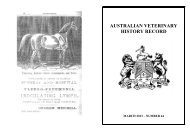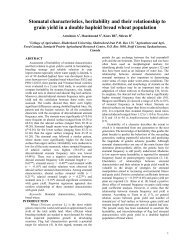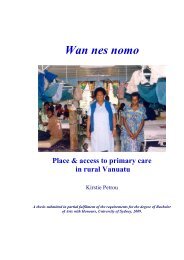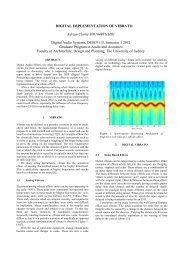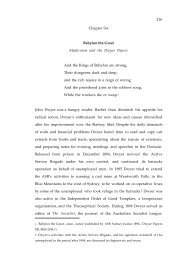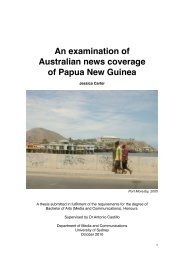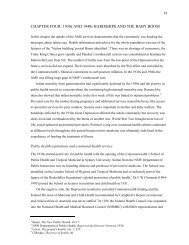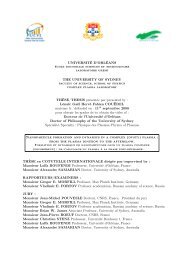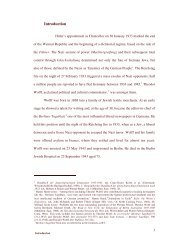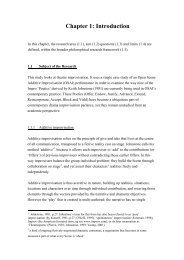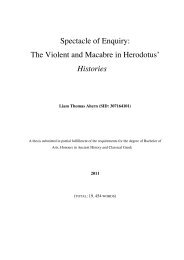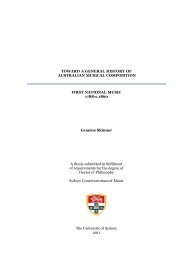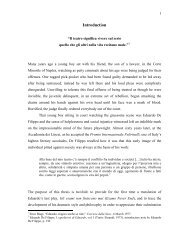Chapter 6: Tense, aspect and mood
Chapter 6: Tense, aspect and mood
Chapter 6: Tense, aspect and mood
You also want an ePaper? Increase the reach of your titles
YUMPU automatically turns print PDFs into web optimized ePapers that Google loves.
as a marker of negated non-past events, <strong>and</strong> of subordinate clauses (Waddy n.d.-b; sections 8.9.1<br />
<strong>and</strong> 8.11.1). In these environments the suffix is obligatory <strong>and</strong> bleached of its meaning. In other<br />
contexts the suffix is entirely blocked, which include: (i) the if-clause of conditionals encoded by<br />
the LOC case suffix -manja, (ii) verbs marked with the PURPosive clitic =yadha, (iii) nominalised<br />
verbs, <strong>and</strong> (iv) the negated past. The absence of the -ma suffix will be argued to also be<br />
semantically motivated: the suffix does not appear on unrealised events.<br />
Table 6.14 repeats the TAM system from Table 6.13 above <strong>and</strong> presents its interaction with the<br />
-ma ~ -mvrra suffix. The ‘+’ sign indicates the presence of the suffix, <strong>and</strong> parentheses mean that<br />
its presence is optional.<br />
Form<br />
Prefix Suffix<br />
Modal meaning -ma ~ -mvrra<br />
Realis<br />
Npast1/2<br />
Non-modal meanings (statements of fact); <strong>and</strong><br />
Occasionally Deontic, Desiderative-intentional<br />
(+)<br />
Past1/2 Non-modal meanings (statements of fact) (+)<br />
Npast1/2<br />
Non-modal future; <strong>and</strong><br />
Epistemic, Deontic, Desiderative-intentional<br />
(+)<br />
Irrealis<br />
Past2<br />
Counterfactual; <strong>and</strong><br />
Deontic, Desiderative-intentional<br />
(+)<br />
+ Negative particle nara: Negated Past -<br />
Imperative Npast1/2 Deontic 2 nd person -<br />
Hortative Npast2<br />
Intransitive Hortative (e.g. let’s go)<br />
Transitive Hortative (e.g. let him kiss her)<br />
(+)<br />
-<br />
a- / ng- Npast3 + Negative particle nara: Negated Npast + (= NP3)<br />
Table 6.14: Enindhilyakwa TAM system <strong>and</strong> the -ma ~ -mvrra suffix<br />
This table shows that the -ma suffix operates partly independently from the TAM system, which<br />
will be demonstrated in more detail below.<br />
The following two examples, taken from the same narrative, illustrate the first person<br />
focalisation function of -ma.<br />
(48) a. Kvni-yamv-na-manja, kenu-warde-na-manja, nungkwa-ja kv-me-na<br />
IRR.3m-do-NP2-LOC IRR.3m/2-hit-NP2-LOC 2.PRO-CofR IRR.2/NEUT-take-NP2<br />
eeka kvnu-warde-na arrkalha.<br />
NEUT.tree IRR.2/3m-hit-NP2 on.the.other.h<strong>and</strong><br />
‘If he does that, if he hits you, you can take a stick <strong>and</strong> hit him back.’ (‘Children’ h20-3)<br />
b. Ngayuwa=dhangwa yiba-ngaji-na-ma eeka-mvrra ki-yama-manja<br />
1.PRO=EMPH IRR.1/2-hit-NP2-ma NEUT.tree-INSTR IRR.2-do.NP1-LOC<br />
arngk-ingka-manja.<br />
NEUT.times-other-LOC<br />
‘I will hit you with a stick if you do that another time.’ (‘Children’ h26-7)<br />
In (48a) the subject is second person, <strong>and</strong> the verbs do not take -ma. By contrast, the subject in<br />
(48b) is 1 st person <strong>and</strong> the verb is marked with -ma. The presence <strong>and</strong> absence of -ma cannot be<br />
226



